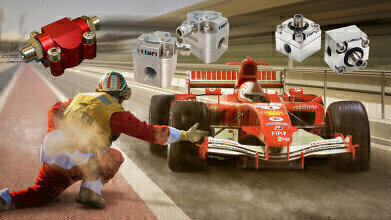Environmental laboratory
Formula One flowmeter expertise provides tailored fuel measurement solutions to transportation sector
May 11 2022
Recent price rises of petroleum and diesel have significantly increased demand for reliable and precise measurements of fuel consumption and hydraulic oil flow within the road haulage and transport sectors.
This is easier said than done; as a rule; fuel consumption and engine efficiency is rarely monitored, diesel engines are checked from their manufacturer’s engine test data, but rarely checked again. Vehicle manufacturers invest considerable time and effort appraising and engine’s consumption figures. These tests are usually carried out by using expensive dynamometers and highly advanced mobile set-ups, which is fine for the manufacturers, but unsuitable and very expensive for general usage. The vehicle’s fuels gauge will measure the fuel left in the tank, but not the engine’s fuel consumption.
Positive displacement flow measurement instruments, for example oval gear flowmeters, offer a solution to accurately and cost-effectively measuring fuel consumption. That being said, results can differ because of the accuracy of the flow meter and there is the potential for inaccurate measurements caused by other factors as well. One such factor would be an increase in the return fuel temperature which will affect the density and viscosity of diesel; in the case of badly maintained engines combustion gases or air may also be present. A small increase in temperature can make engines appear to be extremely efficient because more fuel is seemingly being returned to the tank and less is being consumed. A change in density can cause a 1% volume change if the return diesel is in the region of 25°C higher that the fuel in the tank.
Choosing the right flow computer is extremely important. It needs to have flowmeter linearisation on both channels and be capable of carrying out density corrections utilising pre-determined physical properties of the fuel, as well as fuel flow and return temperature readings. Ideally, the flow sensors should be very repeatable (better than ±0.1%) flow displacement models. Providing that the flow sensors have the requisite level of repeatability, integral temperature measurement, density and flowmeter temperature correction – the operator will obtain an accurate result.
As already mentioned, if the engine is poor running order, the return line may contain a quantity of gas that would raise the apparent volume of return flow. An installed and properly monitored engine flow measurement system can provide an effective indicator of engine decline or other irregularities in the fuel system. Therefore, while the installation a fuel flow measuring system is no easy task, it is possible providing the operator takes into account all flow parameters.
The Virgin Atlantic Challenger II team approached Titan Enterprises back in 1986 to find an instrument to measure their fuel consumption for the Blue Riband Atlantic Ocean crossing attempt. The level of pressure drop permissible was extremely limited if they wanted to maximise the performance of their engine. Their calculations indicated that a venturi meter would meet their needs in terms of loss of pressure; however, the dynamic flow range would not suffice for the engine’s overall fuel use. Titan Enterprise’s solution was to insert on of its Pelton wheels to effectively act as undershot water wheel into the mouth of the venturi; this clever idea gave the team an acceptable level of overall pressure loss as well as superb linearity. The Virgin Atlantic Challenger II broke the record that the ocean liner SS United States had held since 1952.
Back in 2014, a Formula 1 racing team asked Titan to design a couple of bespoke flowmeters. The first to was allow them to obtain direct fuel and engine flow data; for this, Titan developed an ultra-lightweight oval gear meter, which could be installed safely in the fuel tank, submerged in the fuel.
Formula 1 cars tend to run with no cooling fans, therefore obtaining precise oil flow data needed a flowmeter with accuracy of 200oC and no impromptu drops in pressure. Utilising the extremely low pressure drop of their oval gear design Titan were able to create a 200°C, 50 L/minute flow meter featuring a pressure drop lower than 100bar, using oval gear tailored for this application. Despite the extreme conditions you would encounter in such a specialist application both of the unique designs provided reliable and accurate data.
Titan pride themselves on their extensive knowledge and experience that has enabled them to collaborate with their OEMS to provide precise results for all modes of transportation ranging from microlights to trains to racing cars.
Digital Edition
IET 35.2 March
April 2025
Air Monitoring - Probe Sampling in Hazardous Areas Under Extreme Conditions - New, Game-Changing Sensor for Methane Emissions - Blue Sky Thinking: a 50-year Retrospective on Technological Prog...
View all digital editions
Events
Apr 08 2025 Birmingham, UK
Apr 08 2025 Targi Kielce, Poland
Apr 08 2025 Baku, Azerbaijan
Apr 08 2025 Bahrain
Apr 10 2025 Beijing, China




.jpg)














